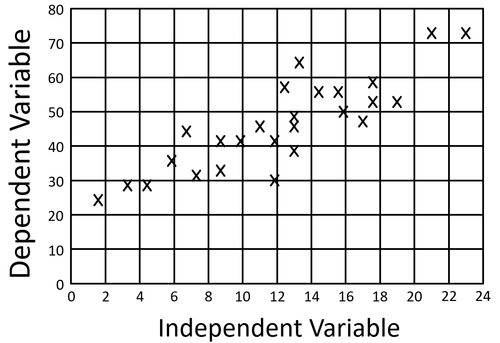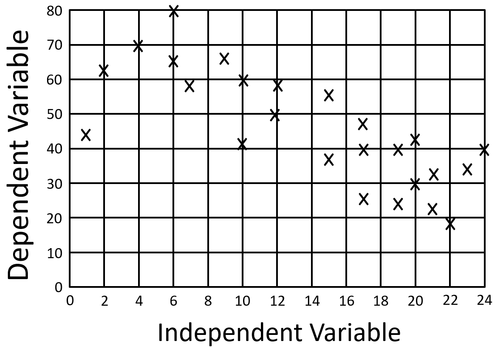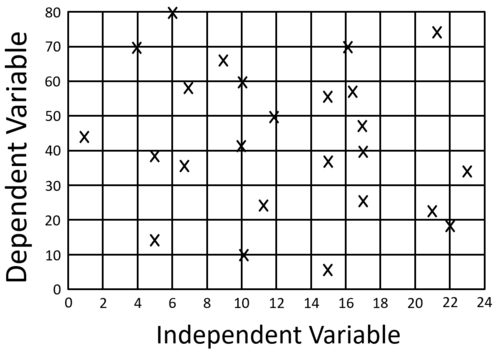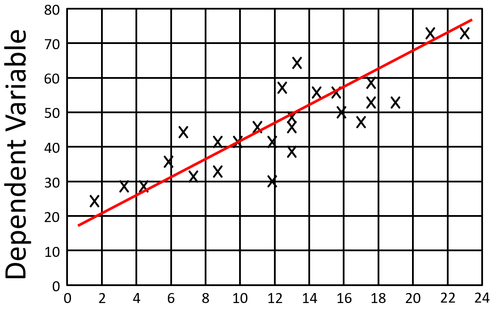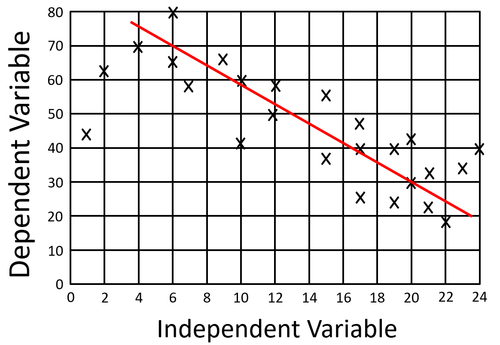Correlation
Contents
Key Stage 3
Meaning
A correlation is when two variables change together.
About Correlations
- Correlations may be positive, where one variable increases, the other variable increases.
- Correlations may be negative, where one variable increases, the other variable decreases.
- A correlation does not mean that one variable causes another. The number of of children diagnoses with autism has increased as the amount of organic food sold has increased. This does not mean that organic food causes autism or that autistic people prefer organic food. It is just a coincidence.
Examples
| This scatter graph shows a positive correlation. |
| This scatter graph shows a negative correlation. |
| This scatter graph shows no correlation. |
Key Stage 4
Meaning
A correlation is when two variables change together.
About Correlations
- Correlations may be positive, where one variable increases, the other variable increases.
- Correlations may be negative, where one variable increases, the other variable decreases.
- A correlation does not mean that one variable causes another. The number of of children diagnoses with autism has increased as the amount of organic food sold has increased. This does not mean that organic food causes autism or that autistic people prefer organic food. It is just a coincidence.
Examples
| This scatter graph shows a positive correlation. |
| This scatter graph shows a negative correlation. |
| This scatter graph shows no correlation. |
References
AQA
- Correlation, page 113, GCSE Biology; Third Edition, Oxford University Press, AQA
- Correlation, page 21, GCSE Biology, CGP, AQA
- Correlation, page 21, GCSE Combined Science Trilogy; Biology, CGP, AQA
- Correlation, page 263, GCSE Physics; Third Edition, Oxford University Press, AQA
- Correlation, page 304, GCSE Chemistry; Student Book, Collins, AQA
- Correlation, pages 115-16, GCSE Combined Science Trilogy 2, Hodder, AQA
- Correlation, pages 16, 19, 20, GCSE Combined Science Trilogy; Physics, CGP, AQA
- Correlation, pages 17, 20, 21, GCSE Chemistry, CGP, AQA
- Correlation, pages 17, 20, 21, GCSE Combined Science Trilogy; Chemistry, CGP, AQA
- Correlation, pages 17, 20, 21, GCSE Physics; The Complete 9-1 Course for AQA, CGP, AQA
- Correlation, pages 40-1, GCSE Physics; Student Book, Collins, AQA
- Correlation, pages 61, 285-6, GCSE Biology, Hodder, AQA
- Correlation, pages 7, 9, GCSE Biology; The Revision Guide, CGP, AQA
- Correlations, page 10, GCSE Chemistry; The Revision Guide, CGP, AQA
- Correlations, pages 7, 9, GCSE Combined Science; The Revision Guide, CGP, AQA
- Correlations, pages 7, 9, GCSE Physics; The Revision Guide, CGP, AQA
Edexcel
- Correlation, pages 8, 10, GCSE Chemistry; The Revision Guide, CGP, Edexcel
- Correlation, pages 9, 17, 20, 21, GCSE Chemistry, CGP, Edexcel
- Correlations, page 166, GCSE Chemistry, Pearson, Edexcel
- Correlations, pages 17, 20, 21, GCSE Physics, CGP, Edexcel
- Correlations, pages 18, 21, 22, GCSE Biology, CGP, Edexcel
- Correlations, pages 69, 108, 280, GCSE Combined Science, Pearson Edexcel
- Correlations, pages 7, 9, GCSE Combined Science; The Revision Guide, CGP, Edexcel
- Correlations, pages 8, 10, GCSE Biology; The Revision Guide, CGP, Edexcel
- Correlations, pages 97, 152, GCSE Biology, Pearson, Edexcel
OCR
- Correlation, pages 239, 288-289, Gateway GCSE Biology, Oxford, OCR
- Correlation, pages 287-288, Gateway GCSE Physics, Oxford, OCR
- Correlation, pages 7, 9, 76, Gateway GCSE Combined Science; The Revision Guide, CGP, OCR
- Correlation, pages 8, 10, Gateway GCSE Physics; The Revision Guide, CGP, OCR
- Correlation, pages 8, 10, GCSE Chemistry; The Revision Guide, CGP, OCR Gateway
- Correlations, pages 8, 10, 102, Gateway GCSE Biology; The Revision Guide, CGP, OCR
